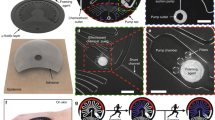Abstract
The objective of this study was to test a device developed to improve the functionality, accuracy and precision of the original technique for sweating rate measurements proposed by Schleger and Turner [Schleger AV, Turner HG (1965) Aust J Agric Res 16:92–106]. A device was built for this purpose and tested against the original Schleger and Turner technique. Testing was performed by measuring sweating rates in an experiment involving six Mertolenga heifers subjected to four different thermal levels in a climatic chamber. The device exhibited no functional problems and the results obtained with its use were more consistent than with the Schleger and Turner technique. There was no difference in the reproducibility of the two techniques (same accuracy), but measurements performed with the new device had lower repeatability, corresponding to lower variability and, consequently, to higher precision. When utilizing this device, there is no need for physical contact between the operator and the animal to maintain the filter paper discs in position. This has important advantages: the animals stay quieter, and several animals can be evaluated simultaneously. This is a major advantage because it allows more measurements to be taken in a given period of time, increasing the precision of the observations and diminishing the error associated with temporal hiatus (e.g., the solar angle during field studies). The new device has higher functional versatility when taking measurements in large-scale studies (many animals) under field conditions. The results obtained in this study suggest that the technique using the device presented here could represent an advantageous alternative to the original technique described by Schleger and Turner.









Similar content being viewed by others
References
Amakiri SF, Mordi R (1975) The rate of cutaneous evaporation in some tropical and temperate breeds of cattle in Nigeria. J Anim Prod 20:63–68
Finch VA, Bennett IL, Holmes CR (1982) Sweating response in cattle and its relation to rectal temperature, tolerance of sun and metabolic rate. J Agric Sci 99:479–487
Gatenby RM (1986) Exponential relation between sweat rate and skin temperature in hot climates. J Agric Sci 106:175–183
McDowell RE, Matthews CA, Lee DHK, Fohrman MH (1953) Repeatability of an experimental heat tolerance test and the influence of season. J Anim Sci 12:757–764
McLean, J. A. (1963a). Measurement of cutaneous moisture vaporization from cattle by ventilated capsules. J Physiol 167:417–426
McLean JA (1963b) The regional distribution of cutaneous moisture vaporization in Ayrshire calf. J Anim Sci 61:275–280
Murray DM (1966) A comparison of cutaneous evaporation rates in catlle exposed to heat in a climate laboratory and in the field. J Agric Sci 66:175–179
Pan YS, Donegan SM, Hayman RH (1969) Sweating rate at different body regions in cattle and its correlation with some quantitative components of sweat gland volume for a given area of skin. Aust J Agric Res 20:395–403
Pereira AMF, Baccari F Jr, Titto EAL, Almeida JAA (2008) Effect of thermal stress on physiological parameters, feed intake and plasma thyroid hormones concentration in Alentejana, Mertolenga, Frisian and Limousine cattle breeds. Int J Biometeorol 52:199–208
Schleger AV, Turner HG (1965) Sweating rates of cattle in the field and their reaction to diurnal and seasonal changes. Aust J Agric Res 16:92–106
Acknowledgements
This study was supported by PRAXIS XXI research programme (FCT, Lisboa) and by ICAM (Évora, Portugal).
Author information
Authors and Affiliations
Corresponding author
Rights and permissions
About this article
Cite this article
Pereira, A.M.F., Alves, A., Infante, P. et al. A device to improve the Schleger and Turner method for sweating rate measurements. Int J Biometeorol 54, 37–43 (2010). https://doi.org/10.1007/s00484-009-0250-3
Received:
Revised:
Accepted:
Published:
Issue Date:
DOI: https://doi.org/10.1007/s00484-009-0250-3




